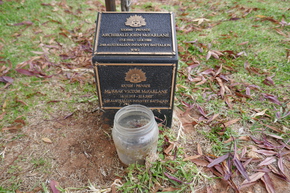MCFARLANE, Murray Victor
| Service Number: | SX7028 |
|---|---|
| Enlisted: | 29 June 1940, Wayville, SA |
| Last Rank: | Private |
| Last Unit: | 2nd/48th Infantry Battalion |
| Born: | Berri, South Australia, 16 October 1919 |
| Home Town: | Cobdogla, Berri and Barmera, South Australia |
| Schooling: | Cobdogla Primary School, , South Australia |
| Occupation: | Family fruit orchard worker |
| Memorials: |
World War 2 Service
| 29 Jun 1940: | Involvement Private, SX7028 | |
|---|---|---|
| 29 Jun 1940: | Enlisted Wayville, SA | |
| 29 Jun 1940: | Enlisted Australian Military Forces (WW2) , Private, SX7028, 2nd/48th Infantry Battalion | |
| 14 Nov 1945: | Discharged | |
| 14 Nov 1945: | Discharged Australian Military Forces (WW2) , Private, SX7028, 2nd/48th Infantry Battalion |
Brothers In Arms
Andrew and Victoria McFarlane lived in the close-knit community of Cobdogla from 1917 onwards and became stalwarts of the community. Andrew became a highly respected fruit grower but he and others in the region experimented with growing potatoes as they were a crop that could remain in the ground during the winter months and thus generate a higher price for the gardeners. However, plagues of grasshoppers decimated the crops some years, but the professional growers from the Adelaide Hills who also had land around Cobdogla, believed the soil was perfect for potatoes, but ideally requiring consistent water to irrigate the crops. This contrasted with heavy rains of 1933 which decimated currant crops and left the McFarlane’s orange block almost a metre under water in places. The local paper recorded the ingenuity of some of the residents when “Water entered several homes and one resident found it necessary to get in his bathing costume, and swimming around in the bedroom he was able to make the furniture secure to the ceiling until the water went down,” displaying the practical ingenuity of the locals.
Murray Victor was born at Berri on the 16th October, 1919, one of fourteen children who all attended the local Cobdogla school, enjoying the annual Combined School Picnic held at the North Lake with other students from nearby Loveday School. This event was attended by parents and students alike and offered sweets, ice cream, cool drinks and refreshments. Sporting competitions were also an integral part of the day with Murray regularly winning races in his age group in successive years, as did his siblings John and Mollie. In 1930, Murray’s prize was donated by the Barmera Bakery Company, one of several local businesses which generously supported the event. In the following year, he won his individual race and the three legged, claiming the overall boy’s Championship in the 11 – 13 age group.
Murray’s success continued in the Annual Berri-Barmera Associated School’s competition where almost 900 students from Barmera, Glossop, Berri, Monash, Winkie, Cobdogla and Loveday marched behind their individual school’s banner, through Barmera to the Memorial Oval. The local MP, Frank McMillan, in opening the day commented that “some or the smallest schools had produced many of the country's greatest men and women” – a prophetic comment in terms of the achievements and contributions so many of the competitors, including Murray, were to make during WWII. Murray himself performed creditably in both the boys’ Under 12 and Under 14 year age groups.
Murray’s regular, unbroken school attendance at Cobdogla was a cause for celebration. Aged 12 and in Year 7 the ‘News’ in August 1932 reported “What is claimed to be a record attendance for Cobdogla School has been established by Murray Victor McFarlane. For six years and seven months he attended school without missing a session. Then, owing to the death of a member of the family, he was absent. In a report to the Director of Education (Mr Adey) the head teacher of the school said that but for his relative's death the boy would probably have completed seven years continuous attendance.” A remarkable achievement.
As a teenager, Murray became a foundation member of the British based Independent Order of Rechabites, a group which encouraged awareness of the dangers of alcohol and drug taking. The first meeting held in 1933 attracted 35 new members in a tent aptly named "Pride of the Murray". Brother Murray McKenzie was elected as a steward. He also was a volunteer in the local Militia and post school helped his father and older brother in the family fruit growing orchard.
When WWII intervened, his older brother, Archibald John McFarlane (John) aged 23, enlisted on June 21st 1940 to be allocated the numbers SX8060. Murray enlisted a week later, just after his 21st birthday in June of 1940 as SX7028 alongside so many others from the Riverland. They both became birthday. Prior to being posted overseas on the Stratheden in November, Murray had pre-embarkation leave in September, spending this back in the Riverland, as did other enlistees from Cobdogla, his brother John, and others in the 2/48th Battalion; Donald Wing SX7969, Albert Matthews SX7503 and Lewis Semmens SX7189.
Murray’s older brother, John was twice wounded, firstly in July of 1941 at Tobruk, John was wounded in action with a gunshot wound to the thorax and abdomen, causing him to be evacuated and spending almost 6 months convalescing in Dimra. Almost 12 months later, he was again wounded this time with another gunshot wound.
Murray was finally discharged on the 14th November 1945. Within a year the local paper reported that he had decided to drive to Coober Pedy to prospect, thence to move on to Queensland, and eventually return to New Guinea, where he did some gold fossicking while a member of the 2nd AIF.
Post-war, Murray’s mother Victoria had a few years to share with her children but died aged 53 in 1948. Both of Murray’s parents are buried in the Barmera Cemetery.
Researched and written by Kaye Lee, daughter of Bryan Holmes SX8133 2/48th Battalion.
Submitted 10 February 2021 by Kaye Lee











